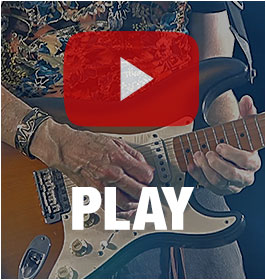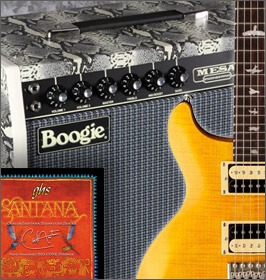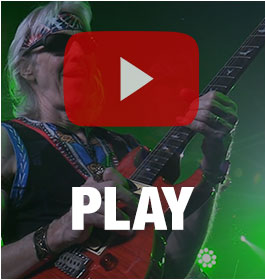Although that was the beginning of the Mesa Boogie amplifier concept, the amplifier was still not fully developed. Guitar players — including Carlos Santana — began requesting Smith’s modified Fender Princeton, and using them on stage and in the studio. However, the complete “cascading gain” technology was yet to come.
The next step in the process happened as Smith was building pre-amps for Crown power amplifiers (the DC-300 model). Not knowing what was required, he tried to cover all contingencies by adding an extra tube stage of gain, and then including volume (actually “gain”) controls at three points in the circuit. Because of an error (he had the speakers plugged into the preamp instead of the power amp), Smith kept turning up the preamp gain controls. When he finally discovered his mistake and plugged the speakers into the power amp, he heard the enormous amount of gain that his preamp circuit could produce. He knew he was onto something big.
Using four 6L6s, Smith built a little 100 watt, combo amp for Santana. It was that original amp which really launched the Mesa Boogie name.
Mesa Boogie and Other Artists
Of course, Carlos wasn’t the only artist to be captivated by the new sound possible with the Mesa Boogie amplifiers. Seminal jazz-rock guitarist John McLaughlin, having just formed the groundbreaking quintet, Mahavishnu Orchestra, immortalized the sound of the Boogie on the band’s first two albums: The Inner Mounting Flame, and Birds of Fire.
Another jazz-rock guitarist, Al DiMeola, introduced the Boogie’s rich tones on his first record with Chick Corea and Return to Forever: Romantic Warrior.
Keith Richards and Ron Wood from the Rolling Stones were drawn to Mesa Boogie amps, as were Pete Townsend of The Who, Frank Zappa, Alan Holdsworth, and a number of other influential players.
Carlos and Mesa Boogie Today
The viability of the Mesa Boogie sound is evidenced by the amount of players that still use the amps, as well as the entire “boutique” amp industry (Bogner, Matchless, Rivera, et al). It’s safe to say that the Mesa Boogie amplifier is an important thread in the guitar tones of the last four decades.
Until recently, Carlos Santana has used Mesa Boogies almost exclusively. An incredible testimonial when you consider that the “Santana Guitar Tone” is an enormous amount of his fame and success. Although Carlos has now incorporated Dumble and Fender amps into his setup, the Boogie remains his central amplifier.
In the end, the relationship between Carlos Santana and Mesa Boogie is one that has been incredibly successful for both parties. If Mesa Boogie helped Carlos create his sound, he in turn became the most visible spokesman for the company, and appeared in several ads during the ’70s, ’80s and ’90s. A match made in heaven!
Mesa Boogie Name
![]() With the “Boogie” part of the name provided by Carlos Santana, Randall Smith needed a more professional sounding company in order to be presentable when ordering parts and doing other work. Inspired by one of his additional jobs — rebuilding engines for Mercedes Benz — Smith came up with “Mesa Engineering.” Combining the two resulted in the now famous “Mesa Boogie” label.
With the “Boogie” part of the name provided by Carlos Santana, Randall Smith needed a more professional sounding company in order to be presentable when ordering parts and doing other work. Inspired by one of his additional jobs — rebuilding engines for Mercedes Benz — Smith came up with “Mesa Engineering.” Combining the two resulted in the now famous “Mesa Boogie” label.
Please feel free to contact the Webmaster with any additions or edits:



